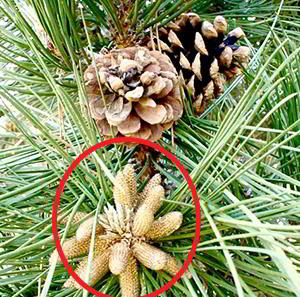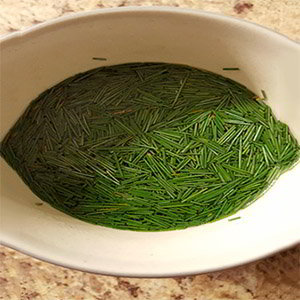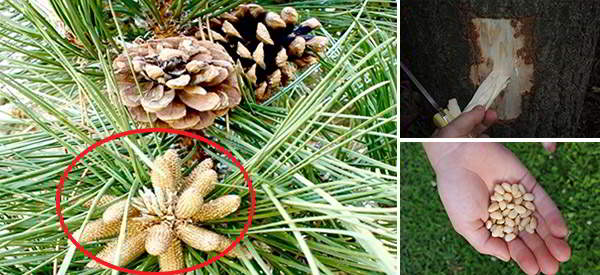Can you imagine eating an entire tree? Probably not. We don’t tend to think of the majority of trees being edible, and only a few parts of the trees we do think of as food are traditionally eaten. In a survival situation or a test of your bush craft skills, you’d do well to keep trees in mind. Specifically, the pine tree proves edible pretty much all the way through.
Pine seems pretty prickly and tough, generally speaking. It’s great for sustenance in a survival situation, though. This is due to the fact that it grows in most every climate zone in the country and as an evergreen, it offers year round resources.
When you think of pine, you probably think of snowy woods, Christmas time, and the crisp, clean scent they impart. For me personally, pine trees always make me think of my grandmother. I’ll never forget her serving my uncle, who was on a healthy eating kick, pinecones covered in chocolate syrup for breakfast one morning when we were visiting as a joke. Turns out, Grandma wasn’t that far off base. Every part of the tree has a use as sustenance. Let’s take a look at how you can use each part.
Seeds
 The seeds of the pine tree, frequently known as pine nuts, are pretty delicious even under the best of circumstances. You’ll find them in many modern-day dishes from pesto sauce to salad toppings. They can be eaten raw or toasted. They’re pretty small compared to most nuts, but they pack the same protein punch. They also have a very high fat content, which is perfect for survival situations.
The seeds of the pine tree, frequently known as pine nuts, are pretty delicious even under the best of circumstances. You’ll find them in many modern-day dishes from pesto sauce to salad toppings. They can be eaten raw or toasted. They’re pretty small compared to most nuts, but they pack the same protein punch. They also have a very high fat content, which is perfect for survival situations.
The real issue with pine seeds is that they’re not easy to get to, and many pine tree varieties contain seeds so small that they’re barely worth the effort unless you genuinely enjoy the little nuts. The pine cones themselves need to be harvested in early fall before the cones open up and release the seeds. You can also find green cones on the trees or scavenge for cones on the ground that have retained their seeds. However, animals really like them, too, so finding them intact on the ground may be uncommon in some areas.
Then the cones need to be dried, either through heat or simply waiting until they’re dry enough to open up. The pine nuts then need to be shelled. You can do this by placing them in a plastic or tightly woven fabric bag and smashing them with a rock or rolling pin. Remove the soft innards. At this point, you’ll want to either eat the nuts within a few days or dry them by roasting or dehydrating them. The fresh nuts degrade fairly quickly.
You can find nuts big enough to be worth your while in a few varieties of pine trees. Learn to identify varieties of pinyon pines, especially the Mexican Pinyon, Colorado Pinyon, and Single-leaf Pinyon. They are the most fruitful, so to speak.
Related: How Our Forefathers Made Glue Out of Pine Resin
Pinecones
 Those pinecones my grandma put on the breakfast dishes weren’t quite edible as large, female, dried pinecones, but there are some pinecones that you can eat. The young, male pine cones can be consumed. This doesn’t mean you can pick them up off the ground and slather them with chocolate syrup for palatability’s sake.
Those pinecones my grandma put on the breakfast dishes weren’t quite edible as large, female, dried pinecones, but there are some pinecones that you can eat. The young, male pine cones can be consumed. This doesn’t mean you can pick them up off the ground and slather them with chocolate syrup for palatability’s sake.
You’ll need to first collect the cones from the tree. The cones that are good for eating are usually still attached. Next you’ll want to boil or bake the cones until they’re tender. You could eat them at this point, but it’s easier to eat them when they’re pounded into flour. You can use the pine cone flour to thicken soups or as a flour substitute. It’s very high in protein, so it’d be perfect in areas where there’s little game to get you by.
Related:How to Make Candles out of Pine Resin (With Pictures)
Bark
 Bark may not seem very appetizing, but pine bark has many possible preparations. When you’re collecting pine bark, it’s important that you take only small strips of bark from several trees rather than harvesting lots of bark from one tree. Stripping lots of bark makes the trees susceptible to disease, eliminating a potential food source for the future.
Bark may not seem very appetizing, but pine bark has many possible preparations. When you’re collecting pine bark, it’s important that you take only small strips of bark from several trees rather than harvesting lots of bark from one tree. Stripping lots of bark makes the trees susceptible to disease, eliminating a potential food source for the future.
The next important pine bark note is that you CANNOT eat the outer bark. You’ll cut through the outer bark to get to the inner soft, white bark. Harvesting this part of the tree can take some practice. You’ll want to use a knife to score a vertical strip down the tree that’s no more than 10% of the total circumference of the tree across. Score horizontally between the two vertical lines. Then, you simply peel the strip of bark away from the tree.
From there, you’ll need to prepare your pine bark. The possibilities here are only limited by your imagination. It can be dried and turned into flour, fried like potato chips, raw, or boiled to help break down the fibrous nature of the bark.
Needles
 Pine needles are a great source of vitamin C. Lack of vitamin C can cause scurvy, which could be a devastating nutritional deficiency in a survival situation. The needles are pretty tough for eating, though, even cooked. In order to get the nutritional value out of pine needles you collect, you’ll likely want to make tea. To do this, finely chop the needles and then boil them in clean for 15 to 30 minutes to taste. Then strain the needles from the liquid and drink it hot or cold, whichever you prefer.
Pine needles are a great source of vitamin C. Lack of vitamin C can cause scurvy, which could be a devastating nutritional deficiency in a survival situation. The needles are pretty tough for eating, though, even cooked. In order to get the nutritional value out of pine needles you collect, you’ll likely want to make tea. To do this, finely chop the needles and then boil them in clean for 15 to 30 minutes to taste. Then strain the needles from the liquid and drink it hot or cold, whichever you prefer.
Related: How to Make Pine Syrup at Home (Step by Step Guide With Pictures)
Pollen
 Pine pollen isn’t available year round, but it’s pretty easy to spot in the spring when it is available. It makes the young male pine cones look like bunches of bananas, an odd sight where pine trees grow. Simply collect the whole bunches and shake off the pollen. It can be used as a high protein flour substitute.
Pine pollen isn’t available year round, but it’s pretty easy to spot in the spring when it is available. It makes the young male pine cones look like bunches of bananas, an odd sight where pine trees grow. Simply collect the whole bunches and shake off the pollen. It can be used as a high protein flour substitute.
Pine Warnings
Pine bark is very fibrous. Eating it raw may cause stomach pain and cramps, so any other preparation is desired over consuming the bark raw.
Some varieties of pine are not only not edible, they’re downright dangerous. Learn to identify these harmful varieties if you’re practicing up on your pine for survival practices. The poisonous varieties are Yew, Ponderosa Pine, and Norfolk Island Pine.
It’s also important to note that white pine varieties are gentler for human consumption than red varieties. You can tell the difference between the two because the needles clusters on white pines contain five needles each which corresponds to the five letters in white. Red pines have three needles per cluster just like there are three letter in the word red.
Pine needle tea may be dangerous for pregnant women and may cause miscarriage. If you’re pregnant or may be pregnant, you might consider avoiding eating or drinking items made from pine in general.
You may also like:
 5 Wilderness Survival Rules That Are Actually Myths
5 Wilderness Survival Rules That Are Actually Myths
World’s Smallest Battery Powers House For 2 Days (Video)
23 Medicinal Plants the Native Americans Used on a Daily Basis
The Only Plant That Should Be in Your First Aid Kit
















This is remarkable….We are surrounded by these pines. I shared it on Facebook and asked if anyone else has known or harvested…Thank you for sharing…
Very amazing information. This could save someone’s life. It is very informative and important information to know. Thank you so much for the article.
It helped save part of the Donner Party in 1846/47.
Very interesting. I would definitely try this.
I gathered up some unopened, large pine cones last year and put them in the garage to wait for them to open. I would suggest heating them as a couple of them have still not opened. I would be really hungry by now waiting for the pine nuts. They do have nuts inside because the ones that did open eventually dropped the seeds. You need lots and lots of pine cones. I now appreciate why pine nuts are expensive.
Great article on Pine. I noticed that the picture of the pine cones with the young male cones circled. I believe this might be a Piñon pine tree. Is that correct?
yes, called pinon=pine, pinon being thr smaller of the two,
Another pine that this looks like is called Austrian pine, but their seeds are pretty small, but bigger than white pine.
i fund this to be really helpful thanks for putting this on the sight
i ment found this to be really helpful thanks